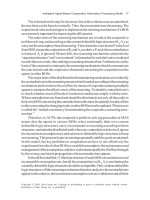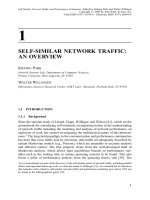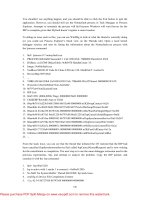Tài liệu Idea Group - Information Management Support Systems And Multimedia Technology P1 doc
Bạn đang xem bản rút gọn của tài liệu. Xem và tải ngay bản đầy đủ của tài liệu tại đây (647.91 KB, 30 trang )
Information
Management:
Support Systems
&
Multimedia
Technology
edited by
George Ditsa
University of Wollongong, Australia
IRM Press
Publisher of innovative scholarly and professional
information technology titles in the cyberage
Hershey • London • Melbourne • Singapore • Beijing
Acquisitions Editor: Mehdi Khosrow-Pour
Senior Managing Editor: Jan Travers
Managing Editor: Amanda Appicello
Copy Editor: Michelle Wilgenburg
Typesetter: Jennifer Wetzel
Cover Design: Michelle Waters
Printed at: Integrated Book Technology
Published in the United States of America by
IRM Press (an imprint of Idea Group Inc.)
701 E. Chocolate Avenue, Suite 200
Hershey PA 17033-1240
Tel: 717-533-8845
Fax: 717-533-8661
E-mail:
Web site:
and in the United Kingdom by
IRM Press (an imprint of Idea Group Inc.)
3 Henrietta Street
Covent Garden
London WC2E 8LU
Tel: 44 20 7240 0856
Fax: 44 20 7379 3313
Web site:
Copyright © 2003 by IRM Press. All rights reserved. No part of this book may be
reproduced in any form or by any means, electronic or mechanical, including photocopy-
ing, without written permission from the publisher.
Library of Congress Cataloging-in-Publication Data
Ditsa, George.
Information management : support systems & multimedia technology /
George Ditsa.
p. cm.
Issued also as an e-book.
ISBN 1-931777-41-1 (soft-cover) -- ISBN 1-931777-57-8 (e-book)
1. Electronic data processing. 2. Management information systems. I.
Title.
QA76.D59 2003
658.4'038'011--dc21
2002156227
British Cataloguing in Publication Data
A Cataloguing in Publication record for this book is available from the British Library.
New Releases from IRM Press
Excellent additions to your institution’s library!
Recommend these titles to your Librarian!
To receive a copy of the IRM Press catalog, please contact
(toll free) 1/800-345-4332, fax 1/717-533-8661,
or visit the IRM Press Online Bookstore at: []!
Note: All IRM Press books are also available as ebooks on netlibrary.com as well as
other ebook sources. Contact Ms. Carrie Skovrinskie at [] to receive
a complete list of sources where you can obtain ebook information or
IRM Press titles.
• Multimedia and Interactive Digital TV: Managing the Opportunities Created by Digital
Convergence/Margherita Pagani
ISBN: 1-931777-38-1; eISBN: 1-931777-54-3 / US$59.95 / © 2003
• Virtual Education: Cases in Learning & Teaching Technologies/ Fawzi Albalooshi (Ed.),
ISBN: 1-931777-39-X; eISBN: 1-931777-55-1 / US$59.95 / © 2003
• Managing IT in Government, Business & Communities/Gerry Gingrich (Ed.)
ISBN: 1-931777-40-3; eISBN: 1-931777-56-X / US$59.95 / © 2003
• Information Management: Support Systems & Multimedia Technology/ George Ditsa
(Ed.), ISBN: 1-931777-41-1; eISBN: 1-931777-57-8 / US$59.95 / © 2003
• Managing Globally with Information Technology/Sherif Kamel (Ed.)
ISBN: 42-X; eISBN: 1-931777-58-6 / US$59.95 / © 2003
• Current Security Management & Ethical Issues of Information Technology/Rasool Azari
(Ed.), ISBN: 1-931777-43-8; eISBN: 1-931777-59-4 / US$59.95 / © 2003
• UML and the Unified Process/Liliana Favre (Ed.)
ISBN: 1-931777-44-6; eISBN: 1-931777-60-8 / US$59.95 / © 2003
• Business Strategies for Information Technology Management/Kalle Kangas (Ed.)
ISBN: 1-931777-45-4; eISBN: 1-931777-61-6 / US$59.95 / © 2003
• Managing E-Commerce and Mobile Computing Technologies/Julie Mariga (Ed.)
ISBN: 1-931777-46-2; eISBN: 1-931777-62-4 / US$59.95 / © 2003
• Effective Databases for Text & Document Management/Shirley A. Becker (Ed.)
ISBN: 1-931777-47-0; eISBN: 1-931777-63-2 / US$59.95 / © 2003
• Technologies & Methodologies for Evaluating Information Technology in Business/Charles
K. Davis (Ed.), ISBN: 1-931777-48-9; eISBN: 1-931777-64-0 / US$59.95 / © 2003
• ERP & Data Warehousing in Organizations: Issues and Challenges/Gerald Grant (Ed.),
ISBN: 1-931777-49-7; eISBN: 1-931777-65-9 / US$59.95 / © 2003
• Practicing Software Engineering in the 21
st
Century/Joan Peckham (Ed.)
ISBN: 1-931777-50-0; eISBN: 1-931777-66-7 / US$59.95 / © 2003
• Knowledge Management: Current Issues and Challenges/Elayne Coakes (Ed.)
ISBN: 1-931777-51-9; eISBN: 1-931777-67-5 / US$59.95 / © 2003
• Computing Information Technology: The Human Side/Steven Gordon (Ed.)
ISBN: 1-931777-52-7; eISBN: 1-931777-68-3 / US$59.95 / © 2003
• Current Issues in IT Education/Tanya McGill (Ed.)
ISBN: 1-931777-53-5; eISBN: 1-931777-69-1 / US$59.95 / © 2003
Information Management:
Support Systems & Multimedia
Technology
Table of Contents
Preface .................................................................................................... vii
George Ditsa, University of Wollongong, Australia
Chapter I. An Intelligent Agent-Based Cooperative Information
Processing Model ..................................................................................... 1
Li Yao, National University of Defense Technology, China
Weiming Zhang, National University of Defense Technology, China
Chapter II. Knowledge-Based Personalization .................................... 26
Tamara Babaian, Bentley College, USA
Chapter III. Customizing Digital Storefronts Using the
Knowledge-Based Approach .................................................................. 34
Fiona Y. Chan, Hong Kong Baptist University, Hong Kong
William K. Cheung, Hong Kong Baptist University, Hong Kong
Chapter IV. Managing Process Compliance ........................................ 48
Larry Y.C. Cheung, Loughborough University, UK
Paul W.H. Chung, Loughborough University, UK
Ray J. Dawson, Loughborough University, UK
Chapter V. Integrating the End User into Infrastructure Systems:
A Customer Centric Approach to the Design and Function of
Intelligent Transportation Systems ....................................................... 63
Thomas A. Horan, Claremont Graduate University, USA
Chapter VI. Implementing the Shared Event Paradigm: Architecture,
Issues and Lessons Learned .................................................................. 78
Dirk Trossen, Nokia Research Center, Boston, USA
Erik Molenaar, University of Technology, Aachen, Germany
Chapter VII. The Effect of Training Set Distributions for Supervised
Learning Artificial Neural Networks on Classification Accuracy ........ 93
Steven Walczak, University of Colorado at Denver, USA
Irena Yegorova, City University of New York, USA
Bruce H. Andrews, University of Southern Maine, USA
Chapter VIII. Executive Information Systems Use in Organisational
Contexts: An Explanatory User Behaviour Testing ........................... 109
George Ditsa, University of Wollongong, Australia
Chapter IX. Culture and Anonymity in GSS Meetings ..................... 156
Moez Limayem, City University of Hong Kong, Hong Kong
Mohamed Khalifa, City University of Hong Kong, Hong Kong
John Coombes, City University of Hong Kong, Hong Kong
Chapter X. Asynchronous and Distributed Multi-Criteria Decision
Making Using a Web-Based Group Support System ......................... 168
Sajjad Zahir, University of Lethbridge, Canada
Brian Dobing, University of Lethbridge, Canada
Chapter XI. Activity Theory as a Theoretical Foundation for
Information Systems Research ............................................................ 192
George Ditsa, University of Wollongong, Australia
Chapter XII. Publishing Model for Web Applications: A User-Centered
Approach ............................................................................................... 232
Roberto Paiano, University of Lecce, Italy
Leonardo Mangia, University of Lecce, Italy
Vito Perrone, Politecnico di Milano, Italy
Chapter XIII. LEZI: A Video Based Tool for Distance Learning .... 256
Mario A. Bochicchio, University of Lecce, Italy
Nicola Fiore, University of Lecce, Italy
Chapter XIV. Electronic Journalism in Peru ...................................... 277
Antonio Díaz, Escuela de Administración de Negocios para
Graduados, Peru
Martín Santana, Escuela de Administración de Negocios para
Graduados, Peru
Chapter XV. An Integrated Network Management Framework
Using CORBA, Mobile Agents and Web-Based Technologies ......... 298
Dongming Cui, The University of Auckland, New Zealand
Jairo A. Gutiérrez, The University of Auckland, New Zealand
About the Authors ................................................................................. 310
Index ...................................................................................................... 318
Preface
vii
Advances in computer technology and information systems have created
new opportunities as well as challenges to the management of information re-
sources. In the past two decades or so, information management has become a
key issue of interest to both researchers and practitioners since the advent of
computers. The issue has become more of a concern and a challenge to both
communities with the tremendous advances in computer technology and informa-
tion systems in recent times. The heightened concern and challenge is, in part, due
to the tremendous amount of information generated with the advancement of com-
puter technology and information systems.
Information support systems are designed in a way to help solve some of the
concerns and challenges of managing information resources. These systems pro-
vide the tools and means of managing information resources on persons, groups,
and organizations. Without doubt, support systems are key topics for current and
future research efforts aimed at maximizing the management of information re-
sources.
Multimedia technology has drastically changed the way we view, interact
with, and use computers. Multimedia technology succeeded in transforming com-
puters to the real “second person.” Like never before, multimedia technology has
made it possible for us to see, hear, read, feel, and talk to computers. Multimedia
technology has transformed and further deepened our understanding and use of
computers in a more meaningful way. Without doubt, multimedia technology is a
key topic for current and future application of information technology.
John Waterworth, in an attempt to draw our attention to the significance of
multimedia technology, states:
viii
The widespread application of technology that combines photographic images,
graphics, text, motion video and audio material in a well-integrated way is
bound to have a major impact on the development of information systems that
are more than word processors, computational number crunchers, or a
combination of the two. This impact will be seen in business, in science, in
education, in the home, and in public places. It will reach people at almost all
levels of society, and will have significant, but as yet unknown, societal impacts.
This makes multimedia a uniquely exciting field to be working at the moment
(1991, p. 20).
Sheu and Ismail (1998) have further stated how multimedia technology has
pervaded our lives and “has forever changed the way we live, work, entertain,
and learn. With wide access to the Internet, kids can spend more time online
experimenting with and learning from computers through the Information Super-
highway than on the TV. Once the power of image, video, and graphic through
high-speed fiber-optics transmission or wireless communication is enjoyed, the
old-fashioned approach of using plain text as a main source of information will be
a thing of the past” (p. xxi).
Multimedia technology has also offered the means and ways of managing
information resources.
This book uniquely combines both issues of support systems and multimedia
technology in information management today. The book has been arranged and
organized having in mind both practitioners and researchers and is, therefore,
suitable for both communities. The book is also suitable for graduates and under-
graduates in support systems and multimedia technology.
ORGANIZATION OF THIS BOOK
This book is organized into 15 chapters. The first chapter, by Li Yao and
Weiming Zhang, presents a Basic Organization Structure (BOS) model for build-
ing a large and complex distributed cooperative information system in large mutual
networks. The chapter argues that a large and complex cooperative information
system and its subsystems in a LAN can be modeled by multi-agent organization
and basic organization respectively; and that with the BOS model, such a coop-
erative information system can be developed easily and is more manageable, ef-
fectively supporting the complicated cooperative methods under certain condi-
tions.
Chapter II presents a novel method for software personalization by which a
set of mechanisms tailored to a particular end user and his or her task can be
achieved. This chapter, by Tamara Babaian, used the proposed method in a
collaborative system called Writer’s Aid. The method relies on a declarative speci-
ix
fication of preconditions and effects of the system’s actions and applies artificial
intelligence, automated reasoning, and planning framework and techniques to dy-
namically recognize the lack or availability of the personal information at the pre-
cise time when it affects a system action and initiates an interaction with a user
aimed at eliciting this information in case it has not yet been specified.
Chapter III, by Fiona Y. Chan and William K. Cheung, further deals with the
concept of personalization, which edges improvement of stickiness of on-line stores.
The chapter describes in detail how to implement a knowledge-based recommender
system for supporting an adaptive store. The chapter proposed a conceptual
framework, which is characterized by a user profiling and product characteriza-
tion module, a matching engine, an intelligent gift finder, and a backend subsystem
for content management.
Chapter IV presents a Compliance Flow Workflow for managing processes.
This chapter, by Larry Y.C. Cheung, Paul W.H. Chung, and Ray J. Dawson, used
model-based reasoning to identify the compliance errors of a process by matching
it against the model of standards used. Some examples, drawn on a draft version
of IEC61508, are used to illustrate the mechanism of modeling compliance checks.
Chapter V analyzes the role of users in enacting Intelligent Transport Sys-
tems functions and services. In this chapter, Thomas A. Horan reviews prelimi-
nary evidence from recent demonstrations and market research studies with a
focus on the role of travelers in producing and using information about traffic
conditions and traveler options. The potential for systems development is then
considered with specific regard to alternative modes of travel, flexible travel, and
emergency and commercial services.
Chapter VI addresses the issue of multimedia in computer supported col-
laborative work (CSCW). In this chapter, Dirk Trossen and Erik Molenaar present
the realization of an application sharing service based on the paradigm of application’s
evolving state, which is mostly suited for closed development or teaching sce-
narios.
In Chapter VII, Steven Walczak, Irena Yegorova, and Bruce H. Andrews
present the effect of training set distributions for supervised learning artificial neu-
ral networks on classification accuracy. The chapter examines the effect of changing
the population distribution within training sets for estimated distributed density
functions, in particular for a credit risk assessment problem.
Chapter VIII presents research into users’ behavior in using a support sys-
tem in an organizational setting. This chapter, written by George Ditsa, used a
model from organizational behavior to investigate factors that explain users’ be-
havior towards using executive information systems (EIS) and identifies the rela-
tive importance of those factors that determine the use of EIS. The chapter dis-
cusses the results of the study and its implications for research and practice.
x
Chapter IX is on culture and anonymity in group support systems (GSS)
meetings. In this chapter, Moez Limayem, Mohamed Khalifa, and John Coombes
used social psychology and Hofstede’s model of cultural differentiation to explain
the different effects of anonymity on the behavior of Hong Kong and Canadian
groups during GSS sessions. This chapter hopes that understanding the effects of
anonymity in different cultural contexts will better inform the design and facilitation
of GSS in the increasingly diverse global settings.
Chapter X presents a detailed model for designing a Web-based Multi-
Criteria Group Support Systems (MCGSS). The model is based on AHP and
uses the intensity of preferences of group members rather than simple voting pro-
cedures. This chapter, by Sajjad Zahir and Brian Dobing, points out the advan-
tages offered by this approach.
Chapter XI presents the basic concepts of the Activity Theory and its poten-
tial as a theoretical foundation for information systems research. This chapter,
written by George Ditsa, argues that the set of philosophical concepts presented
by the Activity Theory makes it possible to marry the human and the technological
aspects of information systems into a more holistic research approach in informa-
tion systems.
Chapter XII, by Roberto Paiano, Leonardo Mangia, and Vito Perrone, de-
fines a publishing model for Web applications starting from the analysis of the most
well-known modeling methodology, such as hypermedia design models (HDM),
OOHDM, WebML, Conallen’s method and others. The analysis focuses on
verifying the state of the art about the modeling of Web application pages; in
particular, the different types of elements that compose the Web page in the mod-
els considered.
Chapter XIII presents LEZI, an experimental software tool oriented to the
production of indexed videos enriched with hypertextual and multimedia elements
for distance learning applications. Written by Mario A. Bochicchio and Nicola
Fiore, this chapter shows how a traditional lesson or a conference can be effec-
tively transformed into a powerful multimedia product based on a very simple and
regular structure.
Chapter XIV, by Antonio Díaz-Andrade and Martín Santana, introduces
electronic journalism as a new trend in the news services that have recently been
boosted by Internet diffusion. Using the Peruvian information media, this chapter
presents electronic media pioneers in the world and the challenges they faced to
deliver news to their traditional and Internet-based customers.
Finally, Chapter XV, authored by Dongming Cui and Jairo A. Gutiérrez,
looks at an integrated network management framework using CORBA, mobile
agents, and Web-based technologies. This chapter proposes a new Web-based









